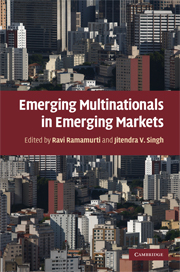Book contents
- Frontmatter
- Contents
- List of figures
- List of tables
- List of abbreviations
- List of contributors
- Acknowledgments
- Part I Introduction
- Part II Country Studies
- 5 Chinese multinationals: Emerging through new global gateways
- 6 Indian multinationals: Generic internationalization strategies
- 7 Russian multinationals: Natural resource champions
- 8 Brazilian multinationals: Surfing the waves of internationalization
- 9 South African multinationals: Building on a unique legacy
- 10 Mexican multinationals: Insights from CEMEX
- 11 Thai multinationals: Entering the big league
- 12 Israeli multinationals: Competing from a small open economy
- Part III Conclusions
- Index
- References
12 - Israeli multinationals: Competing from a small open economy
from Part II - Country Studies
Published online by Cambridge University Press: 03 July 2009
- Frontmatter
- Contents
- List of figures
- List of tables
- List of abbreviations
- List of contributors
- Acknowledgments
- Part I Introduction
- Part II Country Studies
- 5 Chinese multinationals: Emerging through new global gateways
- 6 Indian multinationals: Generic internationalization strategies
- 7 Russian multinationals: Natural resource champions
- 8 Brazilian multinationals: Surfing the waves of internationalization
- 9 South African multinationals: Building on a unique legacy
- 10 Mexican multinationals: Insights from CEMEX
- 11 Thai multinationals: Entering the big league
- 12 Israeli multinationals: Competing from a small open economy
- Part III Conclusions
- Index
- References
Summary
Orthodox IB theory initially depicted MNEs as giant firms based in large, developed home markets. The headquarters of these MNEs transfer technology, management know-how, and capital from the home country to their various subsidiaries. Only much later did some researchers recognize that an MNE could be a knowledge seeker in addition to being a knowledge creator. Established MNEs endeavor to augment their knowledge by getting access to foreign-created knowledge, for example by acquisition of foreign firms. The MNE participates in various kinds of localized knowledge simultaneously (Rugman and Verbeke, 2001). The acquired knowledge is then transferred from one subsidiary to another or even to headquarters.
Today, established MNEs actively search outside the firm for technologies, ideas, and products. Procter and Gamble, for example, expects half of its future products to be based on technologies and concepts it will acquire from third parties (on the process see, for example, Huston and Sakkab, 2006). They acquire new technology rather than transferring existing technologies.
Porter's (1990a, 1990b, 1998) “demand conditions” are a major part of his “diamond.” Firms must have a large home base in order to develop the skills to operate an MNE and to prosper. MNEs possess FSAs that are transferred to a network of subsidiaries in other locations. FDIs, therefore, are assumed to flow from large, developed economies to other developed economies as well as to less developed ones.
- Type
- Chapter
- Information
- Emerging Multinationals in Emerging Markets , pp. 352 - 396Publisher: Cambridge University PressPrint publication year: 2009

